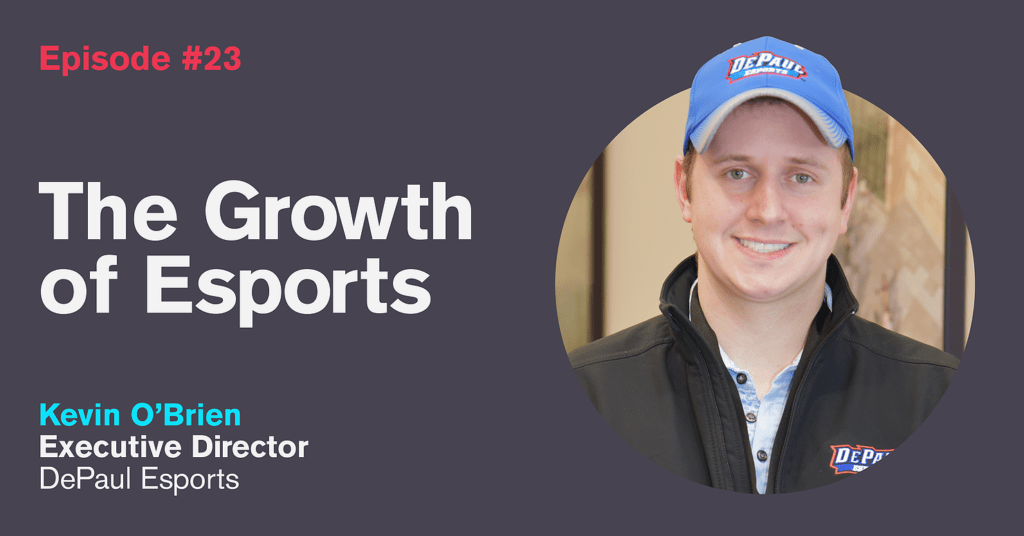Ep. 23: The Growth Of Esports with Kevin O’Brien
In each episode of The GameDay Playbook presented by FanFood, Rob Cressy discusses how leaders are transforming the sports and live entertainment industry by leveraging technology to enhance the fan experience and operate gameday more efficiently. 

Rob Cressy: (00:00) Welcome to The GameDay Playbook presented by FanFood, a discussion around how leaders are transforming the sports and live entertainment industry by leveraging technology to enhance the fan experience and operate game day more efficiently. I’m your host Rob Cressey and joining me today is Kevin O’Brien, executive director of DePaul Esports. Kevin, great to have you on the show. Kevin O’Brien: (00:29) Thank you so much Rob. Glad to be here. Rob Cressy: (00:32) Can you give a quick overview on who you are and what you do? Kevin O’Brien: (00:35) Yeah. I’m the executive director of DePaul Esports and my role is to oversee the student leadership board and help drive our community. We revolve around a lot of different pillars and I make sure that we’re making decisions that best fit our students and continue to grow the program. Rob Cressy: (00:57) So what I want to dive into today is esports in the educational space. And let’s start with this: how did you get involved in this? Kevin O’Brien: (01:09) You know, it actually wasn’t planned. It kind of just came naturally. So I spent my first part of my career as a chef, worked in various Michelin star restaurants across New York and then in Chicago. But when I went back to DePaul, I went for finance. I’m an honors finance student, and I kept reading about esports and tech startups and you know, these new companies are just throwing their money into esports. And I was very curious – what was going on? And so about a year and a half ago, I started doing a lot of research into the space and realized that this is a growing community that really needs to be harnessed within the collegiate space. And it’s also growing from the collegiate side, but it’s growing from the students’ perspective. And so what I really wanted to do is be able to come in and help structure the program and provide the students with the voice, but also allow DePaul University and the faculty to be able to harness that data and the student’s voice to be able to build a program that really accentuates the students but then provides a better college experience. So that’s how I came full circle into the DePaul Esports. Rob Cressy: (02:27) So since all of this is so new for everyone and it’s not like, “hey, bringing on my 25-year esports veteran,” like that doesn’t really exist. So now let’s look at this from the school side of things. How did it get started at DePaul?




Rob Cressy: (00:00) Welcome to The GameDay Playbook presented by FanFood, a discussion around how leaders are transforming the sports and live entertainment industry by leveraging technology to enhance the fan experience and operate game day more efficiently. I’m your host Rob Cressey and joining me today is Kevin O’Brien, executive director of DePaul Esports. Kevin, great to have you on the show. Kevin O’Brien: (00:29) Thank you so much Rob. Glad to be here. Rob Cressy: (00:32) Can you give a quick overview on who you are and what you do? Kevin O’Brien: (00:35) Yeah. I’m the executive director of DePaul Esports and my role is to oversee the student leadership board and help drive our community. We revolve around a lot of different pillars and I make sure that we’re making decisions that best fit our students and continue to grow the program. Rob Cressy: (00:57) So what I want to dive into today is esports in the educational space. And let’s start with this: how did you get involved in this? Kevin O’Brien: (01:09) You know, it actually wasn’t planned. It kind of just came naturally. So I spent my first part of my career as a chef, worked in various Michelin star restaurants across New York and then in Chicago. But when I went back to DePaul, I went for finance. I’m an honors finance student, and I kept reading about esports and tech startups and you know, these new companies are just throwing their money into esports. And I was very curious – what was going on? And so about a year and a half ago, I started doing a lot of research into the space and realized that this is a growing community that really needs to be harnessed within the collegiate space. And it’s also growing from the collegiate side, but it’s growing from the students’ perspective. And so what I really wanted to do is be able to come in and help structure the program and provide the students with the voice, but also allow DePaul University and the faculty to be able to harness that data and the student’s voice to be able to build a program that really accentuates the students but then provides a better college experience. So that’s how I came full circle into the DePaul Esports. Rob Cressy: (02:27) So since all of this is so new for everyone and it’s not like, “hey, bringing on my 25-year esports veteran,” like that doesn’t really exist. So now let’s look at this from the school side of things. How did it get started at DePaul?

